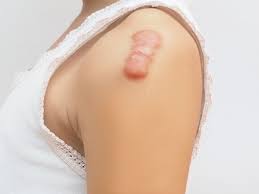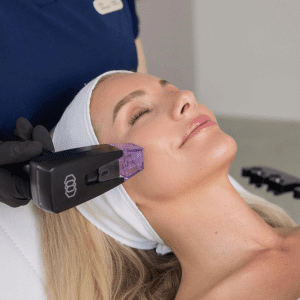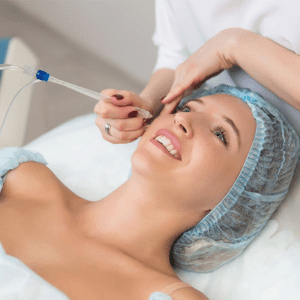
KELOIDS
The healing process triggers keloids to form as firm and elevated scar tissue growths that often become glossy in nature. Typical scars differ from keloids because these growths keep expanding after the initial lesion and extend beyond it. The appearance of keloids on the chest or jawline, shoulders or back, and earlobe areas leads to both pain and itching and noticeable cosmetic issues.
Rasa Derm provides specialised keloid treatment regimens that integrate medicinal and procedural approaches with preventive methods to flatten scars, reduce discomfort, and stop recurrence.
The healing process generates excessive collagen, which forms keloids. The exact cause remains unclear, but research shows several elements that increase the risk:
- Genetic: Genetic factors combined with darker skin tone and a family keloid history make people more likely to develop keloids.
- Trauma Or Injuries: Acne, burns, cuts, scars from chickenpox, and even little scratches.
- Surgery or Piercings: Frequently following surgical wounds or earlobe piercings.
- Inflammation or infections: Surgical site infections and folliculitis and acne can produce atypical scarring.
- A thick elevated scar that develops outside the incision site.
- The keloid displays its colour based on skin tone, which could appear as pink, red, purple, or brown.
- Smooth, glossy, and rubbery to the touch.
- Could be uncomfortable, sensitive, or irritating.
- Gradual expansion over a period of weeks or months.
Comparing Hypertrophic Scars with Keloids
Hypertrophic scars differ from keloids because they remain confined to the injury area, while keloids extend their growth beyond the original boundary. The effectiveness of treatment depends on a correct diagnosis.
Seek medical attention if:
- Your scar is getting worse or hurting.
- The keloid causes limited mobility to your joints while affecting your ability to move.
- The presence of the keloid scar causes you distress because it is visible to others.
- You have several keloids or a history of them coming back.
- You’re considering surgery since you tend to scar unnaturally.
Rasa Derm provides personalised multiple-treatment approaches that depend on the size, location, and age of the keloid. Our practice aims to manage both existing keloids and prevent the development of new keloids.
1. Intralesional Steroid Injections
- Triamcinolone acetonide is injected directly into the keloid.
- Reduces inflammation, collagen production, and scar size.
- The most effective outcomes result from performing the procedure every 3–4 weeks.
- The application of silicone gel sheets or dressings on the scar provides hydration while flattening the tissue.
- Safe for prolonged daily use.
- Helps reduce itching and discolouration.
- The targeted application of lasers helps decrease the size and height of scars as well as their redness and colouration.
- The appropriate laser treatment between fractional CO₂ and pulsed dye lasers depends on skin type and scar characteristics.
- The combination of laser treatment with injections produces superior outcomes.
4. Cryotherapy
- Liquid nitrogen is used to freeze keloids during this procedure.
Best for small or early-stage keloids.
The outcome of treatment becomes more effective when steroids are used in conjunction with cryotherapy.
5. Preventive Care
- The healthcare team at Rasa Derm teaches patients who develop keloids about proper wound care and piercing maintenance and postoperative site care.
- New keloid formation can be prevented through the use of prophylactic pressure earrings combined with silicone dressings and postoperative steroid therapy.
- Early treatment along with regular follow-up care constitutes the foundation for preventing keloid growth.
Why Pick Rasa Derm For The Treatment Of Keloids?
- Skilled dermatologists with expertise in pigmentation control and scar revision.
- Sophisticated in-clinic techniques using precise tools.
- Protocols specifically designed for sensitive areas and skin types.
- Prioritise aesthetic results, recurrence control, and prevention.
- Caring treatment with an eye toward long-term outcomes.
Living With Keloids: Advice & Safety Measures
- People who experience keloid issues should avoid any unnecessary body piercings and tattoos.
- Early treatment of inflammatory skin disorders such as acne proves essential.
- Keloids should remain out of sunlight to prevent the formation of hyperpigmentation.
- Keep scars hydrated and refrain from picking or scratching them.
- It is crucial to inform your dermatologist about any previous keloid formation before surgery.








